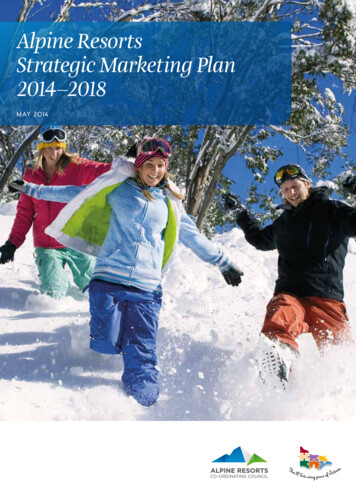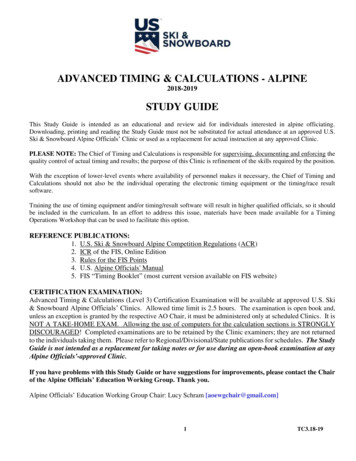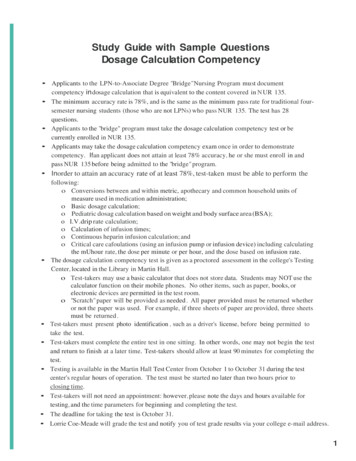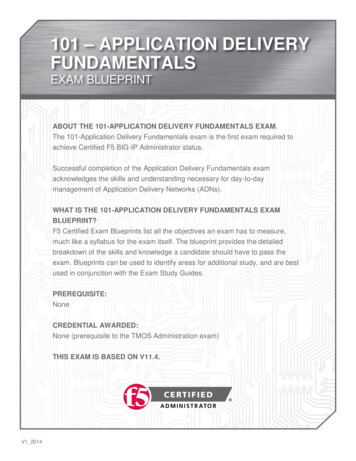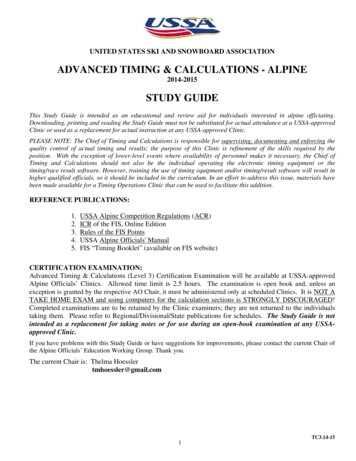
Transcription
UNITED STATES SKI AND SNOWBOARD ASSOCIATIONADVANCED TIMING & CALCULATIONS - ALPINE2014-2015STUDY GUIDEThis Study Guide is intended as an educational and review aid for individuals interested in alpine officiating.Downloading, printing and reading the Study Guide must not be substituted for actual attendance at a USSA-approvedClinic or used as a replacement for actual instruction at any USSA-approved Clinic.PLEASE NOTE: The Chief of Timing and Calculations is responsible for supervising, documenting and enforcing thequality control of actual timing and results; the purpose of this Clinic is refinement of the skills required by theposition. With the exception of lower-level events where availability of personnel makes it necessary, the Chief ofTiming and Calculations should not also be the individual operating the electronic timing equipment or thetiming/race result software. However, training the use of timing equipment and/or timing/result software will result inhigher qualified officials, so it should be included in the curriculum. In an effort to address this issue, materials havebeen made available for a Timing Operations Clinic that can be used to facilitate this addition.REFERENCE PUBLICATIONS:1.2.3.4.5.USSA Alpine Competition Regulations (ACR)ICR of the FIS, Online EditionRules of the FIS PointsUSSA Alpine Officials' ManualFIS “Timing Booklet” (available on FIS website)CERTIFICATION EXAMINATION:Advanced Timing & Calculations (Level 3) Certification Examination will be available at USSA-approvedAlpine Officials’ Clinics. Allowed time limit is 2.5 hours. The examination is open book and, unless anexception is granted by the respective AO Chair, it must be administered only at scheduled Clinics. It is NOT ATAKE HOME EXAM and using computers for the calculation sections is STRONGLY DISCOURAGED!Completed examinations are to be retained by the Clinic examiners; they are not returned to the individualstaking them. Please refer to Regional/Divisional/State publications for schedules. The Study Guide is notintended as a replacement for taking notes or for use during an open-book examination at any USSAapproved Clinic.If you have problems with this Study Guide or have suggestions for improvements, please contact the current Chair ofthe Alpine Officials’ Education Working Group. Thank you.The current Chair is: Thelma Hoesslertmhoessler@gmail.comTC3.14-151
UNITED STATES SKI AND SNOWBOARD ASSOCIATIONADVANCED TIMING & CALCULATIONS - ALPINE2014-2015There is much information available to us - no one can possibly know it all. What we SHOULD knowis WHERE to find it. Most of the sections of this Study Guide require research by the user. This willaid in the ability to understand the layout of applicable rule books/publications and will reinforcetheir content.NOTE: The USSA Schedule Agreement requires that the Chief of Timing & Calculations be appropriatelycertified; certification requires USSA AO Membership. In addition, the Chief of Timing & Calculations forNational Championship, NorAm Cup and World Cup events should be a Level 3 or higher certified Chief ofTiming & Calculations.REFERENCE DOCUMENTS:The following reference items can be found at the end of this Study Guide, in “Miscellaneous Study Guide Forms” oron the FIS website. Document numbering is not sequential because it agrees with document numbering in the “MasterPacket of Forms”. The “Master Packet of Forms” has been updated for season 2014-2015 and can be found on theUSSA website. It is suggested that forms be printed for easy reference while using the Study Guide.39.Timing ChecklistFIS Timing & Data Technical Report ExampleFIS List Cover Page (USSA/FIS websites)36.FIS Penalty Calculation FormFIS “Timing Booklet” (Misc. Study Guide Forms & FIS website)27-28. Replacement Time (Hand) Time of Day (TOD) EET Simplified Example/FormI.Focus of this Study Guide is primarily FIS-level eventsA. Regional FISB. NorAmC. World Cup, World Championship and Olympic Winter GamesII.Characteristics of EventsA. Competitors are top level racersB. Team Captains are highly astute and knowledgeable professionalDepending on type and level of event, 1 or 2 Team Captains may be appointed to serve asConnection Coaches. Connection Coaches:1. Serve as liaison between all Team Captains and the Jury2. Serve as on-hill “Eyes of the Jury”3. May supervise yellow flag zones in DH and SG4. Have voice but no vote in Jury matters/decisionsC. Organizing Committee is committed to a quality event1. Media exposure means that any statement can be news2. Financial commitment entails large sponsorsTC3.14-152
3. Technical Delegate, Referee, and Assistant Referee as appointed by the Technical Delegate(speed events only) [601.2.3, 601.4]D. Race Organizing Committee (ROC; or Organizing Committee – OC) is highly experienced andqualifiedE. Race Jury1. World Cup: FIS Chief Race Director and FIS Race Director serve as Referee and AssistantReferee for all events – both speed and technical [601.2.1]2. World Championships and Olympic Winter Games: All Jury members, including Start andFinish Referee, are appointed by FIS and have voting rights [601.2.2]3. In all other races* the Technical Delegate appoints the Referee and for Downhill and SuperG, the Assistant Referee [601.2.3]4. By appointment, the above become members of the Organizing Committee [601.2.4]*Referee, Assistant Referee and Course Setters are appointed by Nor-Am Cup Committee for Nor-Am Cupevents. These officials are also appointed by USSA for Championship events.F. Additional support officials, as required, have a high level of certification, knowledge andexperienceG. Professional Timing Company and Timing System Requirements [611]H. FIS Computer Company1. FIS Pointsa. Validity (4.2.4 – the current season)b. Rule Observance (1.1 – not observed; race not scored)c. FIS List (5.1 – FIS List is only available electronically; software that enables access isavailable at ftp://fisski.ch.) Software data and other publications are also available.d. FIS Points may only be corrected by FIS Bureau. FIS Points on FIS website version ofFIS Points List that are marked “C” are verified as being “confirmed”.2. NorAm Cup Points are used for seeding of the first group of fifteen (15). They are updatedafter each event.* (Due to greater number of athletes qualified for Europa Cup, differentprocedures apply for Europa Cup, e.g.: 30 in first group/special group 450 points.)a. Entry to NorAm Cup events are quota controlled.b. Overall 400-point holders from prior and current season are seeded at 16th positionc. Overall 400-point holders who were injured and unable to utilize special seeding duringprevious season may use it at the first 3 races of the following season. This is valid for amaximum of 3 starts irrespective of the events.d. Overall 400-point holders are followed by the present competitors ranked within the top30 of the FIS points list.3. World Cup Points are used to seed first group of thirty (30); updated after each event.*a. Overall 500-point holders from among top 30 WCSL present are seeded at 16th positionb. Overall 500-point holders from remainder of field are seeded no later than 31st position*Refer to current Continental Cup Rules and World Cup Rules if more detail is required.TC3.14-153
III.What is SCORING?A. Dimensions of scoring are:To ensure that ALL scoring functions come together and function as a unit: Classic ICRdescriptions are found as follows: Chief of Timing & Calculations [601.3.6]1. Chief Timekeeper [612.4]2. Assistant Timekeepers (Manual/Hand Timekeepers) [612.5]3. Finish Controller [612.6]4. Chief of Calculation [612.7] (When appointed.)B. Scoring interacts with:1. Timing Company2. Scoring Computer Company3. Announcera. A run or race that is rescheduled for a later time slot on the same day is delayedb. A run or race that is rescheduled to a different date is postponedc. A run or race that is started but cannot be completed is terminated. There is no setnumber that has to start or finish. If even one forerunner has started and the Jurydetermines that the event cannot continue, it is a “terminated” event.d. A run or race that will not be held is canceled; cancellation of an event vacates the USSArace code/FIS codex and invalidates the event liability insurance.e. Announcer should be available to announce competitors’ unofficial times.f. Announcer should be available to announce DSQ’s. When an announcer is announcingunofficial times, DSQ competitor data announcement can replace posting of Report bythe Referee. Team Captains must be notified beforehand if announcement of DSQinformation is going to replace actual posting. [617.2.2]4. Secretariat5. Press Chief6. Technical Delegatea. Verifies timely synchronization of timing equipmentb. Verifies accuracy of Official Results and Penaltyc. Verifies accuracy and signs “FIS Timing & Data Technical Report Form” prior to itselectronic transmission to FIS7. Referee (Report by the Referee).a. Chief of Timing or Assistant should track/enter DNS and DNF bib numbers on theReport by the Refereeb. Chief of Timing should meet with Referee (and Assistant Referee for speed events) andassist with entering DSQ competitor data, e.g.: Name, team, Gate Judge, type of fault/rule.NOTE: Due to force majeure, the Technical Delegate may prepare, sign and post the Report bythe Referee or may assign this duty to another official. A Report by the Referee signed by theTechnical Delegate or designee is valid.8. Jurya. In cases of system malfunctions, e.g. timing systems, Jury allows provisional rerunsTC3.14-154
b. In cases of doubt, Jury allows provisional reruns not based on system malfunctionsc. In cases of doubt, Jury allows provisional startsd. Confirms validity of provisional starts and provisional rerunse. Establishes start intervals for GS, SG, and DH and communicates the intervals(fixed/regular) to Chief of Timing or assistant.f. In cooperation with Chief of Timing or assistant, establishes start intervals for Slalom(non-fixed/irregular)g. In accordance with rules regarding minimum start intervals, establishes start intervals forGiant Slalom, Super G, Downhill Training and Downhillh. Confirms start intervals for Giant Slalom, Super G and Downhill and communicates anychanges with Chief of Timing or assistant9. Provides instruction to manual/hand timekeeping crew in order to provide required manualtimekeeping that is consistent and accurateC. QUALITY - Establish confidence in "Real Time" timing/scoring presentations1. Familiarize yourself with available timing systems: Start, Finish, Net Time2. Verify scoreboard is available with: Bib #’s, Names, Unofficial Times3. Verify location of intermediate timing points4. Verify location and accuracy of video displays5. Furnish progress reports to media with respect for deadlines6. Document DNS and DNF on Report by the Referee and be available to verify DSQcompetitor data, e.g.: Bib, Name, Team7. Aid in preparation of accurate official reports according to formatIV.Initial Actions of Scoring are:A. Establish presence with the following:1. Secretariat: Verify Race Secretary is using updated race result software, current/applicablePoints List and confirmed technical data, etc.2. Timing Company: Verify use of homologated timing equipment3. Scoring Computer Operations: Verify scoring software has been updated and is compatiblewith race result software4. Chief of Manual/Hand Timing: Verify availability of supplies, equipment and knowledge ofprocedures5. Technical Delegatea. Confirm timely synchronization of timekeeping equipment: electronic & manualb. Prepare Timing & Data Technical Report for Technical Delegate’s review/signaturec. Oversee electronic transmission of Timing & Data Technical Report to FISd. Provide consistency and accuracye. Be available to verify all official timesB. Facilities and Schedules1. Verify schedule for Team Captains' MeetingTC3.14-155
2.Verify schedule for creating seed board3.Verify location of Press Room and identify press room liaison personnel4.Verify location and availability of results reproduction facilities5.Inspect Finish Building and Finish Line/Finish Area [615.2]a. Finish Photocells: Are they approved?b. Width between Finish Posts1.) DH and SG finish line dimensions – no less than approximately 15 m*2.) SL and GS finish line dimensions – no less than approximately 10 m*3.) Line is marked horizontally with a coloring substance so that it is clearly visible tothe approaching competitor4.) Timing equipment/competitor security installation*Distance is between finish posts/banners not length of finish line. Timing postsmust also adhere to these measurements.6.Start Area, Start Facilities and Start Gate/Area specifications [FIS “Timing Booklet 2.50”]a. Homologated Start Gatesb. Dimensions1.) Width: Support posts should be 50 – 80 cm apart2.) Wand should be mounted approximately 35 – 50 cm from the snowc. Start Wand Installation1.) Description: small diameter fiberglass rod2.) Mountinga.) Only one wand is permittedb.) Wand cannot be so stiff that it could cause injury or not break, but must be stiffenough to eliminate false startsc.) Wand must stay open once it is triggered; auto return wands are not permittedd.) Duplicate start wand must be on hand for replacement purposese.) Mounted horizontally above the starting line and at an elevation that places it at orbelow a racer’s kneesf.) Mounted on a hinge. As the racer propels forward across the starting line, thewand is forced to swing forward and to the side by the racer’s leg. Placement ofstart gate must be marked on the support posts.g.) Replacement must be with identical gate, at same position and with same rotationh.) If two start gates are used in concert, they must be solidly mounted on samephysical bracket. Both mechanisms and box must be stiffly connected together.NOTE: Refer to current FIS Timing Guide for information regarding angular rangeand accuracy of the start wand.3.) Starting Gatea.) Minimum of 2 electrically isolated contacts activated by 1 wand.b.) Timing wires must be connected to separate start gate contacts using separateconnections.c.) Wand must be installed so that starting is impossible without it opening.TC3.14-156
d.) Exact replacement wand must be available, if required4.) Communicationa.) Wiring between the start wand and the timekeeper’s booth is generally availablethrough another pair or wires or is piggybacked onto an existing pair – usuallybackup.b.) A headset may be plugged into a jack at the start so that the Starter can be inconstant voice communication with the timing room7. Accompany Jury on course inspection and check for the following:a. Location of “yellow flag” zones and “blind” areas. FIS is reviewing language regardingyellow flag zones. Possible change may include Giant Slalom as an event requiring useof yellow flags.b.V.Location and staffing of intermediate timing positionsQuestions You Need to Ask:A. Are all entries in? Are all entries on the Board? (This is important for DHT where rules requirethat all qualified competitors be entered and drawn in all training runs.)B. What computer-scoring program is being used and has it been updated?C. Does it meet the requirements of 611.3.5 which requires that computer software that calculatesnet times must use precision of ToD as used in the timing device?D. Is the correct and current Points List available?E. Is the scoring computer up to date on entries?F. Have all the preliminary reports been prepared?G. What is preparation status of timing facilities? (Refer to #39. Timing Checklist)H. Has all of the header data been entered in the computer?I. What timing equipment is being used?J. What system will be used to transfer data between results computer and timing1. Transfer of race file which does not allow the RA to perform race data editing during race2. Transfer of timing file which involves only bib numbers and times and does allow for racedata editingK. What start gate is being used?L. What finish photocells are being used? Photo Finish timing has been approved for use at FISevents for backup purpose. FIS has established criteria for photo finish systems, and they must befollowed (see current edition of FIS “Timing Booklet”). Due to the cost of the equipment, it willmostly be used at OWG, WSC, WC levels.M. Are timing equipment, start gates and finish photo cells all on the homologated lists? [611.2]TC3.14-157
NOTE: All timekeeping equipment MUST meet stipulated standards. Use of equipment that does notmeet standards will result in an event not being considered (scored).N. Are requirements for electronic data transmission of Official Results and Penalty – wireless ornetwork – in place?It may seem that we are delving into areas of responsibility belonging to other officials; however, it isnecessary to be sure that the interfaces are going to function smoothly and efficiently. There is not enoughtime to try to fix things while the competition is in operation. Since the Chief of Timing & Calculations orScoring should evaluate these interfaces and take whatever action is necessary to get the job done withoutsacrificing QUALITY!VI.Quality Assurance ActionsA. Team Captains’ Meeting, Seeding and the Draw. According to USSA and FIS rules, the drawmust be conducted (or confirmed) at a Team Captains' Meeting. An actual meeting, attended inperson by Team Captains, Jury, and race officials is an inseparable and mandatory part of thecompetition and is important for communication of Jury instructions, support of the ROC, aswell as conveying ROC requests and information. It is also a critical element for riskmanagement and liability-related matters. [Refer to 621.8, 604.3]With the approval of the Jury and at a time and place announced to all Team Captains, andwhere a computer-assisted Draw has been approved or is not required (e.g. YSL where TRS byclass and gender is used to determine the start order), an informational meeting is still requiredbut may be held either immediately after the completion of a race for the next day's event or onthe morning prior to a race.For all Team Captains’ Meetings for all USSA-sanctioned events—both scored and non-scored,and regardless of where and when they occur, an Attendance List must be available and signedby everyone attending the meeting. Meeting Minutes must be generated and must be included inthe submitted race result packet.1. Keep in close touch with Secretariat2.Attend Team Captains' meetings3.Recheck the Seed Board before and after Drawa. Verify accuracy of the Boardb. Verify seed-point ties are identifiedc. Verify correct seeding of competitors entitled to 16th/31st position, if applicable (USSA“Golden Rule”, FIS NorAm & FIS World Cup)d. Verify grouping of competitors without pointse. Verify additional special seeding groups as authorized by the Jury4.Verify correct application of rule regarding “Snowseed”?5.Verify number of available Forerunners6.Independently record the Draw7.Recheck the Start or Training List against the Boarda. Verify header information against the appropriate source: Homologation fileb. Verify accuracy of footer informationNOTE: USE OF ELECTRONIC SEED BOARDS: Electronic seed boards must have thecapability to simultaneously and legibly display the entire competition field. Simultaneousdisplay of all competitors allows all Team Captains and officials to verify the overall accuracy asTC3.14-158
well as additions and deletions to the starting order in “real time”. Using the race result softwareto display portions of the competition field is not acceptable. (USSA Software – Split Second isdeveloping a “Tool” for electronic Draw/Seed Boards.)B. Downhill Training1. Verify all timing equipment and personnel will be in place for all training runs2.Verify accuracy of Start List in scoring computer3.Address intermediate timing considerationsa. Timing machine operatorsb. Necessity of having on-hill operators4.Multiple Time Basesa. Verify that score board, either electronic or paper, is available to display competitors’timesb. Verify that forerunners' times will not be displayedc. Verify accuracy of Time-of-Day printoutsd. Verify status of press room video displays, if availablee. Verify status of Announcer's display, if available5.Press Reports (UNOFFICIAL) Standard format not requireda. Establish contact with Chief of Pressb. Establish system for press report production and distribution1.) Verify accuracy of documents released to press2.) Keep copy of all documents released to press3.) Cooperate with electronic transmission to Press Room if no runner is available6.Other ReportsAccurately prepare all required reports in a timely mannerC. Race Day - Be prepared for the unexpected.1. First Runa. If possible, attend Jury inspectionb. Verify schedulec. Verify amount of 2nd Run “Bibbo” [Reverse 15? 621.11.3]d. Verify synchronization checks with TD; assist with compilation of “Timing & DataTechnical Report” (Refer to #40. FIS Timing & Data Technical Report Example):1.) Online filing required for all FIS events. The required program is currentlyavailable at /AL.It isavailable for Linux, MacOS and Windows, and program updates will be posted onthe website as required.2.) Paper copy filing required for all USSA-scored, and USSA non-scoredChampionship (e.g. U12 Championships, Masters Championships) events. FISprogram can be used to produce a paper copy report, as required, for USSA nonFIS events. The report may need to be edited to include the USSA race letter codeas the program only allows for four numbers. (When the software is used for aUSSA event, presence of FIS logo is a non-issue.)e. Verify course and weather data for headers and communicate the information to RA/DMTC3.14-159
f. Follow preparations of timing and computer operationsg. Verify instructions for manual/hand timekeeping crewh. Verify measurement by wheel, tape or GPS for DH and SG has been accomplishedi. Recheck start order in computerj. Plan press report production; follow plank. Keep "Report by the Referee" up to date by noting bib # for DNS and DNF competitorsl. Observe timing company operations1.) Verify accuracy of time-of-day printout2.) Verify accuracy of interval timing reports prior to distribution3.) Make notes on Start List4.) Track differential between main and backup timing5.) Identify five best (lowest) point holders who start race regardless of resultm. Print unofficial listing immediately after last competitor finishesn. Meet Jury at finish with complete unofficial listing and “Report by the Referee"1.) Assist Referee/Assistant Referee with review of Gate Judge Cards2.) Provide a copy of unofficial competitors’ ranking for the Technical Delegate3.) Deliver DSQ list to announcero. Publish Unofficial Results reportp. After protest period verify appropriate action taken on DSQ's with computer operationsq. Print/verify 2nd Run Start List or 1st Run Resultsr. Verify that Race Administrator is aware of any Jury decisions that may requiredocumentation (Jury Minutes), e.g. application of chemicals, change in start order,change in start times, change in announced start intervals for Giant Slalom, Super G,Downhill Training and Downhill2. For Second Run of Two-Run Eventsa. Assist TD with synchronization checks; assist with completion of “Timing & DataTechnical Report” datab. Verify 2nd Run cutoffsc. Verify accuracy of Second Run Start List.1.) “Bibbo”; check for ties at last position of flipped group (30th or 15th)2.) Verify start order of ties outside of “bibbo”3.) For USSA scored non-FIS events, verify if 1st DNF/DSQ competitors are includedon 2nd Run Start Listd. Complete additional duties performed during 1st rune. If time permits, complete hand calculation of Penalty and include calculation draft whenmeeting with Technical Delegate after race.TC3.14-1510
VII.Review and UpdateA. Factors: DH - 1250SL - 720GS - 980SG - 1080AC - 1150B.FIS Points are calculated to 999.00. USSA uses 999.99 to indicate an athlete has no earnedUSSA Points.C.Competitors qualified for the event must be entered and drawn for all Downhill Training runs.D.Photo Finish Timing (611.3.2.2): A Photo Finish System may be used to determine acompetitor’s finish time. In case of a failure of system “A” and “B”, and where the competitionhas been recorded by the Photo Finish System, this time must be used in place of hand times(manual times) using a correction factor.The correction factor is the difference between the time taken by the Photo Finish System andthe electronic times (where possible) of the 3 competitors before the missed time. Where thereare not 3 previous competitors then the time of a competitor(s) immediately after the missedtime can be used.The sum of the 3 (or less) time differences divided by 3 (or less) is applied to the photo finishtime of the competitor without an electronic time.The photo finish time is taken when any part of the competitor’s body first crosses the finishline.Photo finish result is only provided to the Jury!E.Wireless Timing: According to Precisions, what is it and when can it be used?F.Early/Late Start rule violations and penalty [613.6, 613.7, 805.3 & 805.4]G.Delayed Start rule violations and penalty [628.5]H.Results for Limited Finishes: How many racers have to finish in order for an event to bescored?1. USSA: “Ghost” racers with maximum value points may be added to bring total of finishersto 5; no race penalty can be calculated when there are fewer than 3 finishers. [2013 AlpineCompetition Guide: Rules for USSA Race Penalty Calculations - Fewer than Five RacersFinish.] Penalty will have to be calculated manually; “ghost racers” must not be insertedinto the race scoring software.2. FIS: 5 must be classified; 3 must have FIS points. [4.4.4, Rules of the FIS Points]I.Race Points [4.4.3, 4.4.6] are not calculated higher than maximum.J.Category Adders are competition level, gender and event specific.K.“Z” (Correction Value) is gender and event specific. A positive number is subtracted; anegative number is added.L.Validity of Result: [4.2.4] A FIS result is valid for the current season.M.Continuing on course after losing one ski (FIS only): [614.2.4] If a competitor loses a skiwithout having committed a gate fault or without coming to a complete stop, he may continue,as long as he- does not interfere with the run of the next competitor or,- has not been passed by the next competitor.N.Fall in Finish - when manual/hand timekeepers take time [611.3.1]O.Gate Fault Prior to Crossing Finish: Status of a racer who commits a gate fault prior tocrossing the finish line [611.3.1]TC3.14-1511
P.Secondary Electronic Timing: Used when primary fails1. ICR ruling [611.3.2]2. FluctuationsIf system allows manual intervention of timing, timing tape must be marked. [611.3.4] It isa good idea to mark times that will require a replacement time (EET).3. It is not permitted to substitute time-of-day times from System B for use withSystem A for the purpose of net time calculations. [611.2.1]Q.Replacement Time (EET) - ICR description [611.3.2.1] (Refer to #27. & #28. ReplacementTime (Hand) EET-Simplified)1. Use for secondary timing adjustment, if primary timing fails2. Use if both primary and secondary timing fails3. Use in reverse fashion to adjust electronic time to equivalent manual/hand time, if required4. Include calculation(s) with copy of TDTR submitted to individual appointed by the USSATiming Working Group to review a Division’s TDTR’sR.Timing Record: Primary and, if required, secondary timing tapes are the official timing recordfor the event and must be used to proof computer input.S.Timing Tapes: Deliver timing tapes to Technical Delegate [611.3.3]. After TechnicalDelegate’s review, the tapes remain with the ROC. Force majeure may require that theTechnical Delegate retain possession of the timing tapes.T.Online Filing of FIS Timing Data Technical Report (TDTR) FIS requires online filing of the“Timing Data Technical Report” (TDTR). A paper copy of the online report must be madeavailable for inclusion in required electronic or paper copy race result document packets asnoted in “Distribution of Documents – FIS Events”.The TDTR program is available for download (MAC and Windows) on the FIS ftp ingReport/AL); it will be updated as required.Please verify that the current version is being used.The FIS program can be used to produce a paper copy report, as required, for USSA non-FISevents. The software does accept “National Race Code” which is used for a USSA Transmittalnumber (alpha character 4-digit number); “Race Codex” is left blank and either “CHI –Children” or “JUN – Junior” category must be selected. The XML file must not be submitted toFIS for non-FIS events or to USSA as USSA is not currently set up to accept the timing reportXML file.U.FIS Penalty: (Refer to FIS List Cover Page and #36. FIS Penalty Calculation Form)1. Understand procedure [4.4]a. Identify event levelb. Select genderc. Select event for Adder and “Z” (Correction Value) [4.4.7, 4.5]1.) If the “Z” is positive, it is subtracted2.) If the “Z” is negative, it is added2. Understand procedure when current seed points are above maximum value or do not exist:a. Maximum value is assigned to competitors who are ranked in the top 10 in time whoseactual seed points are above the maximum valueb. Maximum value is also assigned to competitors who are ranked in the top 10 in time andhave not earned FIS pointsTC3.14-1512
3. Understand how to recognize and apply rules regarding ties in Penalty calculationa. Tie 10th place in time: consider all ties to select best (lowest) 5 seed pointsb. Tie 5th best (lowest) seed points - higher race pointsc. If competitors to whom maximum value has been assigned are being considered amongthe 5th best (lowest), competitors who had “actual” FIS Points are chosen first4. Penalty calculations
TC3.14-15 1 UNITED STATES SKI AND SNOWBOARD ASSOCIATION ADVANCED TIMING & CALCULATIONS - ALPINE 2014-2015 STUDY GUIDE This Study Guide is intended as an educational and review aid for individuals interested in alpine officiating. Downloading, printing and reading the Study Guide must not be substituted for actual attendance at a USSA-approved


